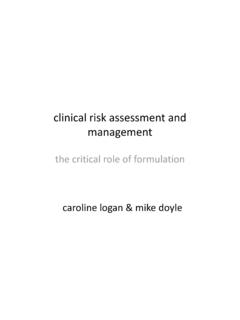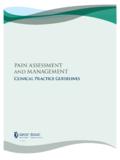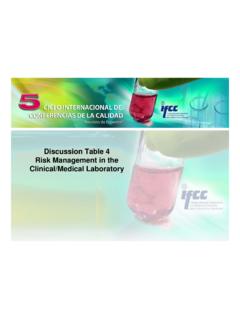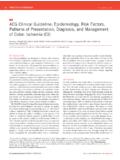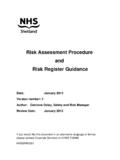Transcription of Documentation in Clinical Social Work: Ethical and …
1 Documentation in the Human Services: Ethical and Risk- management IssuesFrederic G. Reamer, of Social WorkRhode Island CollegeProvidence, Rhode IslandThe Role of Documentation assessment planning and delivering services accountability: clients, insurers, agencies, other providers, courts, utilization review continuity and coordination of services supervision evaluation of services Core Documentation Issues Content Language and terminology Credibility Access to records and documentsEthical risks Mistakes Ethical judgments Ethical misconductStandard of CareWhat an ordinary, reasonable, and prudentpractitioner, with the same or similar training, would have done under the same or similar Negligence:Key Elements Clinician has a duty Evidence of breach or dereliction of duty concerning Documentation Harm or injury Evidence of proximate cause (or cause in fact an uninterrupted causal connection between the breach of duty and harm)Forms of Negligence Acts of commission Misfeasance (wrongful exercise of lawful authority; performing a proper act in an injurious manner) Malfeasance (wrongdoing; performance of a wrongful or unlawful act) Acts of omission (or nonfeasance)Assessing Your Documentation Protocol To evaluate the quality of your Documentation , conduct a thorough assessment of the policies and procedures you use to document.
2 [The following protocol is excerpted from: Frederic G. Reamer, The Social work Ethics Audit: A Risk management Tool(Washington, DC: NASW Press, 2001). It includes an outline of key issues to address when you examine the adequacy of your Documentation . The first section focuses on your policiesand the second section focuses on your procedures.]Assessing Documentation Policies Documentation : The agency has appropriate policies in place to ensure proper Documentation . 1 point - no risk:clear, comprehensive policies exist concerning practitioners Documentation in client records, consistent with relevant laws, regulations, and Ethical standards 2 points - minimal risk: policies concerning practitioners Documentation in clients records exist, but require minor revision 3 points - moderate risk: policies concerning practitioners Documentation in client records exist, but require significant revision; policies concerning aspects of practitioners Documentation in client records need to be created 4 points - high risk: existing policies are inadequate or are seriously flawed.
3 Policies need to be created to address a significant number of issues related to practitioners Documentation in clients recordsKey Content: Policy _____Social histories, assessments, and treatment plans _____Informed consent procedures _____Contacts with clients (type, date, time) _____Contacts with third parties _____Consultation with other professionals _____Decisions made and interventions/services provided _____Critical incidents _____Instructions, recommendations, advice, referrals to specialists _____Failed and canceled appointments _____Previous or current psychological, psychiatric, and medical evaluations _____Information concerning fees, charges, payments _____Termination of services _____Final assessment _____Inclusion of relevant documents (for example, consent forms, correspondence, court documents, fee agreementsKey Content: Procedures Documentation : The agency has appropriate procedures in place to ensure proper Documentation .)
4 1 point -no risk: practitioners routinely follow proper procedures when they document in clients records 2 points -minimal risk: practitioners usually follow proper procedures when they document in clients records, but there are exceptions 3 points -moderate risk: practitioners are very inconsistent in their use of proper procedures when they document in clients records 4 points -high risk: practitioners rarely or never follow proper procedures concerning Documentation in clients recordsKey Content: Procedures _____Social histories, assessments, and treatment plans _____Informed consent procedures _____Contacts with clients (type, date, time) _____Contacts with third parties _____Consultation with other professionals _____Decisions made and interventions/services provided _____Critical incidents _____Instructions, recommendations, advice, referrals to specialists _____Failed and canceled appointments _____Previous or current psychological, psychiatric, and medical evaluations _____Information concerning fees, charges, payments _____Termination of services _____Final assessment _____Inclusion of relevant documents (for example, consent forms, correspondence, court documents, fee agreements) Documentation Tip #1 Strike a reasonable balance between including too much information and not enough information.
5 Include information that is essential in order to be accountable to (a) the client, (b) colleagues/agency, (c) third-party payers, (d) utilization review organizations, and (e) courts of law. Avoid including gratuitous information, , sensitive information that is not essential or Tip #2 Carefully review the language you use to document. Be careful to avoid defamation of character. Defamation of character occurs when (a) you say or write something that is untrue; (b) you knew that what you said or wrote was untrue or you should have known that it was untrue; and (c) the party you wrote or talked about was harmed. Defamation of character can occur in two forms: slander (oral communication) or libel (written communication). Documentation Tip #3 Handle Documentation errors with great care. Avoid white out. Acknowledge errors clearly and forthrightly. Documentation Tip #4 Avoid ambiguous Tip #5 Avoid broad characterizations: poor outcome, good result, moderate compliance, drunk, aggressive, combative always include specific evidence to support conclusionsDocumentation Tip #6 Do not over document in a crisisDocumentation Tip #7 Document as soon as possible and edit Tip #8 Print or write Tip #9 Do not document interventions before they Tip #10 Use correct grammar and spelling (credibility issue).
6 Documentation Tip #11 Do not tamper with or alter Tip #12 Do not document staffing problems in clients recordsDocumentation Tip #13 Do not document professional disagreements ( jousting ) in clients recordsDocumentation Tip #14 Always include the evidence that supports your Tip #15 Document what you know, not what you Tip #16 Know how to respond to subpoenas of your Tip #17 Handle personal notes carefully; be aware of the Tip #18 Document carefully when providing services to couples or Tip #19 Become acquainted with key federal and state regulations. Prominent examples include: 42 CFR Part 2 (Confidentiality of Alcohol and Drug Abuse Patient Records) 34 CFR Part 99 (Family Educational Rights and Privacy Act or FERPA) Health Insurance Portability and Accountability Act (HIPAA) Documentation Tip #20 Be familiar with provisions in pertinent state statutes, contracts, and codes of ethics related to: Client access to records Record retention Record storage Protection of clients and collaterals confidentiality and privacyThe Importance of Careful Wording and DocumentationA panda walks into a caf.
7 He orders a sandwich, eats it, then draws a gun and fires two shots in the air. Why? asks the confused waiter, as the panda makes towards the exit. The panda produces a badly punctuated wildlife manual and tosses it over his shoulder. I m a panda, he says, at the door. Look it up. The waiter turns to the relevant entry and, sure enough, finds an Large black-and white bear-like mammal, native to China. Eats, shoots and leaves. From Lynne Truss, Eats, Shoots & Leaves(New York: Gotham Books, 2003).The Importance of Careful Wordingand Punctuation: Examples A woman, without her man, is nothing. A woman: without her, man is nothing. The people in the queue who managed to get tickets were very satisfied. The people in the queue, who managed to get tickets, were very satisfied. A cross-section of the public. A cross section of the material is drawn from: Frederic G. Reamer, Social work Malpractice and Liability (2nded.)
8 New York: Columbia University Press, 2003. Frederic G. Reamer, The Social work Ethics Audit: A Risk- management Tool. Washington, DC: NASW Press, 2001. Frederic G. Reamer, Ethical Standards in Social work : A Review of the NASW Code of Ethics (2nded.). Washington, DC: NASW Press, 2006. Frederic G. Reamer, Documentation in Social work : Evolving Ethical and Risk- management Standards, Social work , 50(4), 2005, pp. 325-334.
